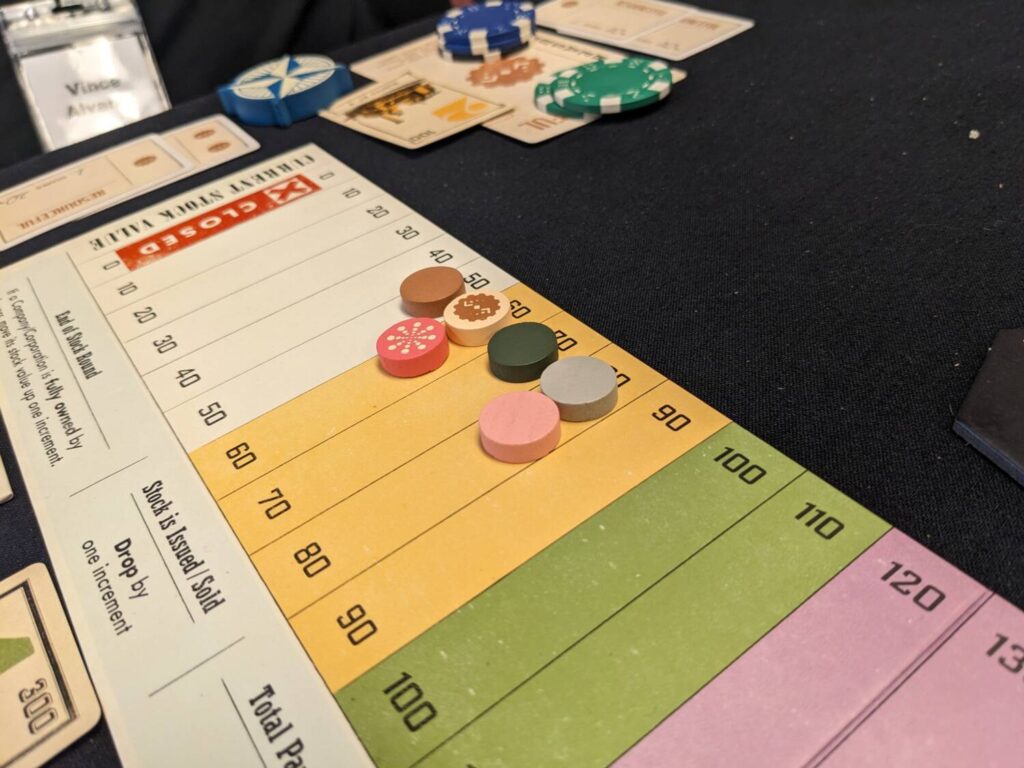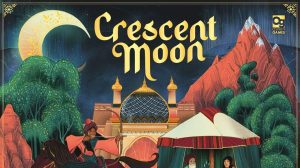The thing I struggle with most when playing 18xx games over and over again? I love the system, the private companies, the merger opportunities, the operational interaction, and sometimes even the financial shenanigans. But the maps are static.
What if I could find a game that used an 18xx framework but is played on a modular map? That’s something I would throw my money at in a heartbeat.
Last fall, I found the crowdfunding campaign for Railways of the Lost Atlas, an 18xx game created by first-time designers Kevin Delger and Jacob Schacht of Asterisk Games. One look at the campaign page told me this was serious, and after throwing my money at these guys, my initial promise was rewarded with one of the most communicative fulfillment processes I have ever seen.
While I usually have to wait years and not months to get my copies of crowdfunded games, something weird happened: the game showed up on time, about nine months later. I had the chance to play Railways of the Lost Atlas at the 18xx gaming convention TraXX earlier this year, and after adding my two plays at TraXX to two more plays since my personal copy arrived, I have to say—
Bravo. Bravo, Asterisk, for rewarding our faith in your process. For keeping us abreast of the situation at every turn. For designing then developing a sturdy gaming system that should conceivably grow with future iterations, be it expansion content or additional games. For making a beautiful yet reasonably-priced product.
Railways of the Lost Atlas is not perfect. But for those of us seeking a “weeknight train game” that fulfills then innovates on the 18xx formula, there won’t be another game this year that beats what I’ve seen so far.

Choo Choo (or, Choo, For Short)
Railways of the Lost Atlas (ROTLA) is a 2-5 player game that shares most of the bones of what the 18xx system features in other better-known iterations. It has trains, map tiles, rust events, the opportunity to pay out or withhold, shares, off-board locations, minors, majors, mergers, and train exports. If you are familiar with other 18xx games, you’ll feel right at home with the system on display with ROTLA. (And if you are not familiar, feel free to read my piece on my own 18xx introduction from last year.)
But after confirmation that ROTLA has most of what you’d expect in an 18xx game, things change quickly…as quickly as you open the manual. This rulebook is, quite easily, the most accessible 18xx rulebook in history. The manual’s approach is straightforward, clean, and does a fantastic job of explaining the rules to both 18xx newcomers and veterans alike. Because the game doesn’t use a specific historical reference, there’s nothing wasted in the front of the manual about the particular period of time in the 1800s when the game may or may not take place. It’s just…go.
And the going is well written. The layout is great. I love the font here; it feels like “olden time”, but I don’t know exactly when. It almost feels like the font used for The Game of Life (the original one, back in the 1950s or 60s). In some ways, the font is grim, serious. Train games are usually for serious people, and this tone feels on point for the kinds of people who I have met during my personal train game journey.
I applaud the way certain rules are broken with the use of minor companies in real time. In a section describing the way to compute the revenue value of a basic city, there’s a small icon that alerts players that this rule changes if the Suburban minor is in play. It’s a small detail, but it allows the reader to keep moving while noting these changes with notes in the margins.
The rules lay out options in a way you won’t be used to, if you play a lot of 18xx games. That’s because of the variety built into the game formats. You could play a standard version of ROTLA, with up to five players and the largest version of a map and all the available trains. That version has a limited number of “cycles”, consisting of a stock round, two operating rounds (ORs), an optional merger round, then a train export before doing it all again for a total of six cycles.

Looking for a weeknight train game? ROTLA has you covered, not just with one format, but options within those formats. You could play the Short Game, where you only play four cycles instead of six. I did that once for this review, with one player who had played 18MS: The Railroads Come to Mississippi and another who was familiar with 18xx-adjacent, incremental capitalization games like City of the Big Shoulders, and we finished in just under two hours.
Short on players? No sweat. The Short Game works with 2-4 players, but you could also try the Micro Game format instead. A good fit for two, maybe three players, this is featured on an even smaller map (a bit like the upcoming title from All Aboard Games, System18) and plays in about 90 minutes. I played the 3-Player Micro Game with a pre-set map included in the rules with two players who were brand new to 18xx concepts and our game took just over 90 minutes, with final scores that ended in the low $2,000 range. Those rookies got a taste of what a full game would look like, without the time commitment of a 3-4 hour game.
The rules also include more variants to make train game life easier—or, more hostile—depending on your audience. A bit like other 18xx titles such as 1822PNW, ROTLA allows players to run “local” trains where revenue is only the number on one tile, not a route between two destinations. This gives players who are running companies that are cut off a chance to continue making money. Hostile mergers are here as well, and there are some fun ideas around added revenues for a central headquarters location if players want to spice things up a bit.
All of this is great. But the reasons I recommend ROTLA are threefold—the minors, the leadoff train concept, and the map. It is these elements that will make ROTLA sustainable outside of my train gamer network because of the Euro-style elements that augment play.

Here’s Why You’ll Come Back
Let’s start with the minor corporations. There are 12 minors in the box, all of which have a single signature power. Adaptive Company can establish its single home hex on any empty basic city hex on the map. While most minors have one hub token, Expansive Company has a second token that can be placed to expand its range. Northern Port Company has a special set of tiles that generate additional income, while Bridging Company can lay yellow track on top of water hexes.
During stock rounds, players bid for the right to choose from a selection of available minors, anywhere from 1-3 minors at a time. The winning bid is the initial treasury money available to that minor when it runs, and its five shares are spread between its president, other players, and the minor’s treasury. I like this model, which combines the requirement to run minors first in games I love (such as 1861: Railways of the Russian Empire) with private companies that would normally have to be auctioned during a typically arduous private company auction.
Some minors are not available, based on the game format chosen by the players and when those minors appear in the auction order. But each minor has an advantage that, when paired with the minor’s randomly drawn home location on the map built by the players, really makes the auction process juicy.
The second element I enjoy is the idea of a “leadoff train.” It’s the thing that has left most players asking the same question after play—why wouldn’t ALL future 18xx designs give players a chance to buy a train before a new company’s first operating round? In ROTLA, the first action a minor company president can take is to buy a single train from the stack of available trains (or from the bank pool). That way, the new company can earn revenue on its first turn during the run routes phase.
When I read the rules for ROTLA, I was intrigued by this idea…after four plays, I can’t imagine playing an 18xx game without this feature. Of COURSE I want to make money right away. Of COURSE it makes sense that players don’t want to waste an entire turn sliding backwards on the stock market track because it didn’t operate. Of COURSE it makes thematic sense that a pizza delivery company president would buy cars before trying to deliver pizza—the most important thing to a delivery network is to have transportation.
Why would I lay track before I own something to travel on that track????

Later, if a company has mismanaged its business, minors are not allowed to buy a leadoff train…only if the minor is performing its first operating round. So, it’s not an ongoing power, and players who experience a rust event still have to buy a train. Leadoff trains, people. We need ‘em!
The minors and leadoff trains are great. But you should try ROTLA because of the map system. The map setup is great, and it already needs improvement because players are going to want more variety in the tri-hex tiles included in the box. (Maybe “improvement” isn’t the right word…how about “options”?)
To start each game, players will shuffle then slowly reveal and place chunky tri-hex tiles that form a map of whatever land you want to imagine for your game. Some of the tiles have nothing but empty plains hexes. Some form the outside border of the map, or situate red off-board areas that will be used for distant destination deliveries. Some have $40 mountain hexes, while others have water hazards. The rest feature one of each game’s minor company home tile, which build excitement as players consider which minors they want to operate.
For three of my four games, we have used the standard setup. (The game comes with a small number of pre-designed maps. While I appreciated this gesture, you’re going to want to do the standard setup to see the magic of the early game.) This always leads to what I like about the best maps of other 18xx games—some minors have strictly better starting situations. When adding this to the merger possibilities, ROTLA has a genuinely thrilling setup, which I think is lacking in many other 18xx titles.
The map created by players is going to have a funny sprawl to it. Because of how the tiles are added, gaps will pop up from time to time, and players can collectively choose to fill those gaps with a small assortment of single hex tiles that can nestle comfortably in-between existing tiles.

Keep It Handy
Railways of the Lost Atlas is quite an achievement. I was most excited by the praise levied by other gamers I met at TraXX regarding the design, and the praise from those players (I did a three-player Short Game and a four-player Long Game at TraXX) was universal—ROTLA shakes up a stodgy corner of the hobby with something fresh, accessible, and surprisingly beautiful for a “boring train game”, in the words of my two children.
One note about that praise—I only later realized that all my ROTLA opponents at TraXX were players who appeared to be younger, maybe in their late 20s to early 40s. Comparing ROTLA to more seasoned 18xx veterans such as Shikoku 1889, 1830: Railways & Robber Barons, and heavier fare such as 1822: The Railways of Great Britain or 1817, I think ROTLA might break along generational lines in terms of the players. I’m already curious to see if older and more tenured players embrace ROTLA and its unique take.
I like that I could play this as a normal 18xx game, with the six full cycles and a more normal series of trains coming and going across a large board. The “merger moment” in ROTLA is really special, in part because of the minor certificate design and the way two minor certificates fit perfectly underneath a major corporation charter with a bright, colorful display showcasing the ongoing powers of the newly-formed major. It sounds silly, but each time a player mergers their companies, everyone oohs and aahs at the new look of the paperwork.
ROTLA is a handsome product. Despite its dry-looking exterior packaging, the items inside really shine, and the game earns complements each time it comes out. Also, the player aids are perfect and summarize most of what is needed. I wish there were 2-3 more aids that summarized the powers of the minor companies, but between the one aid that has that info, a larger sheet on the back of the tile manifest, and the rulebook, that info can be found.

Small areas of concern have shown up across my plays. The most consistent one, at least from the train gamer professionals, is the choice of purple to represent the third-level tile upgrades that take place after the purchase of the first 5 (permanent) train. In every other 18xx game I’ve tried, third-level upgrade tiles are brown. I’m not as offended by this as others, in part because I see that Asterisk is trying to pave a different path and in part because I love the color purple. But, I’m surprised this isn’t called out anywhere in the rulebook.
The minor companies that are put up for auction can sometimes hit a snag, particularly late in the game when players don’t want to put a single company up for bid because the available minors are in compromised positions on the map. There is not a rule regarding the reshuffling of minors once play begins, so I found myself in one case interested in reshuffling the available companies so that a different company was on top. This may help move the game along, but this is another one that I’m surprised to not see addressed in the rules.
One area of concern is more a surprise than a true concern: I was really hoping ROTLA would become my new 18MS. By this, I mean the game I would teach to 18xx newcomers. That hasn’t turned out to be the case. That’s a testament to how well 18MS plays, in terms of both speed but also in terms of concepts. 18MS is more closely aligned to how other 18xx games play, in both a positive and negative way (and sadly, there are no leadoff trains in 18MS).
ROTLA is a blast to play, but the map setup alone means that the experience is not as transferable to other games. There are no private companies that pay a small revenue to owners, like most other 18xx games I own, and when mergers occur, minor company powers persist in ROTLA but they wouldn’t in many other games where private companies close at a certain point.
None of this is bad; it’s just a surprise. After my first play, I was running around thinking that ROTLA would be my new 18xx intro game…and I think that was a mistake.
Railways of the Lost Atlas is going to hit the table a lot in the months to come. I’m glad I made the purchase to add it to my permanent collection, and I’m already excited to see what Asterisk is working on next. If you are new to the 18xx category or a veteran looking for something a bit different, give Railways of the Lost Atlas a good look!










